Ebbs and Flows
The Art of Adaptation in Times of Impermanence
“Ebbs and Flows” explores the profound teachings of water: Its quiet power capable of shaping landscapes, its adaptability through constant change and its malleability to fit any vessel. The concept aligns perfectly with Henki Art’s ethos of exploring diverse expressions of water and their metaphorical significance to inspire audiences with its profound depth and beauty. The exhibition draws inspiration from water’s resilience and fluidity, inviting the viewers to contemplate the impermanence of all things and find strength in the fluid nature of existence, a particularly relevant theme in today’s rapidly changing world.
🔊 Before you begin exploring Ebbs and Flows, we invite you to take a moment to listen to this short introduction. In just over a minute, you’ll hear the story behind the exhibition – its guiding themes, the artists involved, and what we hope you’ll take with you from this experience.
Artists
Ivan Alagakov is a Russian artist whose paintings and graphic works explore the relationship between inner perception and external reality. Combining elements of surrealism and conceptualism, Ivan uses ink, oil, and tempera to create metaphorical compositions that invite contemplation. A graduate of Saint Petersburg State University of Culture and Arts, Ivan has exhibited internationally, including at the “35×35 Russian Art Project” in Athens, and has collections in the CFAM Museum in Athens.
Ola W. Tappert is a Swedish artist whose abstract mixed media works capture the landscapes of Österlen. Using earthy tones and layered textures, Ola explores the interplay of stillness and movement in nature, evoking a sense of calm and transition. His work has been featured in Residence Magazine and exhibited at Konstrundan, Österlen.
Kang Ruan is a Chinese artist based in Chengdu who blends traditional Chinese artistic philosophies with Western influences like Impressionism and Abstract Expressionism. His oil paintings explore themes of nature, transformation, and human connection. A graduate of Neijiang Normal University, his work has earned awards such as the Bronze Award at the 2023 Hong Kong Contemporary Art Awards and has been featured in Yanhuang Geographic Magazine.
Curator
Sissy Alcántara is a curator dedicated to creating meaningful connections between art and its audience. With a formal background in Art Curation, Art History, and Gallery Management from Mombo Art in Spain, she brings a knowledgeable perspective to her projects. Since 2023, she has worked as an independent freelance curator, collaborating with artists across diverse mediums, from traditional Thanka to contemporary multimedia and photography. Sissy’s curatorial approach is rooted in diversity, open communication and a collaborative spirit, aiming to create accessible and impactful exhibitions
Interactive Viewing Room
Archived
Sunset on the Luga River
Ivan Alagakov, Oil on hardboard, 48 x 26.5 cm, 2022

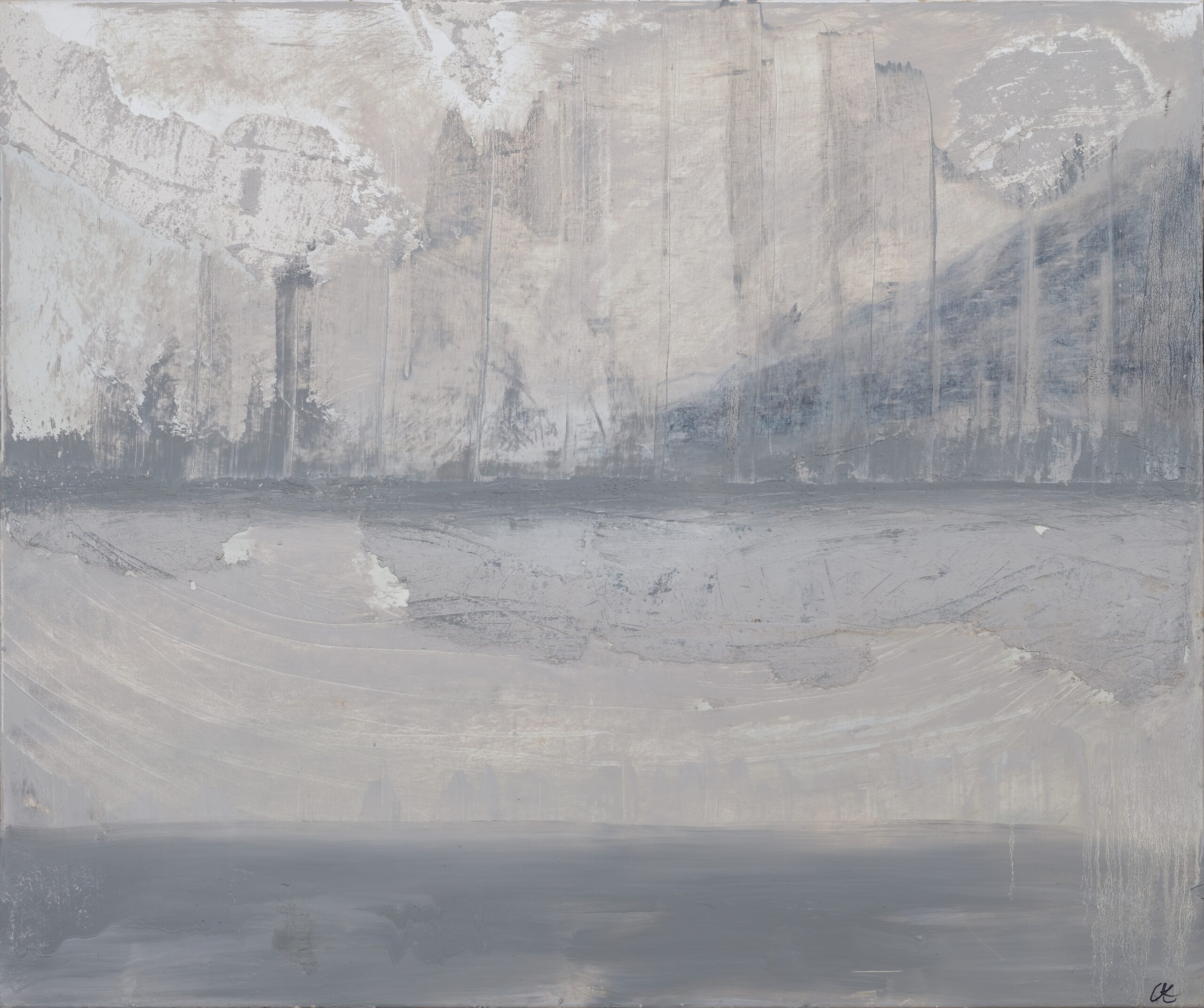
Sandkullen
Ola W. Tappert, Mixed Media, 100 x 120 cm, 2024
The Rhythm of Change
How the concept of fluidity and impermanence shapes artistic practice
Ebbs and Flows explores the theme of adaptation and impermanence, drawing inspiration from the fluidity of water. How does this concept resonate with your artistic practice, and how do you see it reflected in the work?
Ivan
This is one of the most important themes for me. My work often explores the tension between the permanent and the transient. Particularly this is evident in the fluid, surreal, moving forms of my black and white drawings, where the shapes transform from one into another, but also the theme is researched in my paintings too.
For example, I have a series of works dedicated to an Althea flower bush, which I painted over several years to document shifts in my perception and style. A similar theme is present in the "Ebbs and Flows" exhibition: every year I visit a secluded village on the Luga River and often paint the same spot on the shore. Contemplating the calm, yet moving stability of these waters, which have served (and sometimes threatened) people for centuries, is incredible. And most likely, they will outlive humanity. Painting the same riverbank over time highlights the water’s enduring yet ever-changing presence - a silent witness to human impermanence.
Ola
The concept of "Ebbs and Flows" mirrors much of what I explore in my artistic practice. My abstract landscapes are inspired by the nature of Österlen – a place where the sea, the light, and the landscape are constantly changing. I am fascinated by the transitions: between sky and sea, between seasons, between clarity and dissolution.
In my art, I do not capture a specific moment, but rather a sense of movement and change – much like the ebb and flow. The coasts and open fields of Österlen carry a natural rhythm that I try to express through layers of color and form. For me, painting is a way of approaching the cycles of nature, where nothing is static, and everything is in motion. I want the viewer to experience both stillness and movement – like the water that retreats and returns, over and over again.
Kang
The ideas of change and adaptation are at the core of how I paint. In Red-Billed Blue Magpie, I layer translucent glazes that build up and wash away, much like erosion, letting the image slowly emerge through both control and chance, just as water shapes land over time. In Spring, I focus on fleeting light and shifting colors, making solid forms like branches or petals feel temporary, always in motion. This sense of impermanence isn’t about loss, but about constant transformation.
For me, painting is like working with water itself, fluid, unpredictable, and always evolving.
New Green
Kang Ruan, Oil on canvas, 120 x 100 cm, 2024
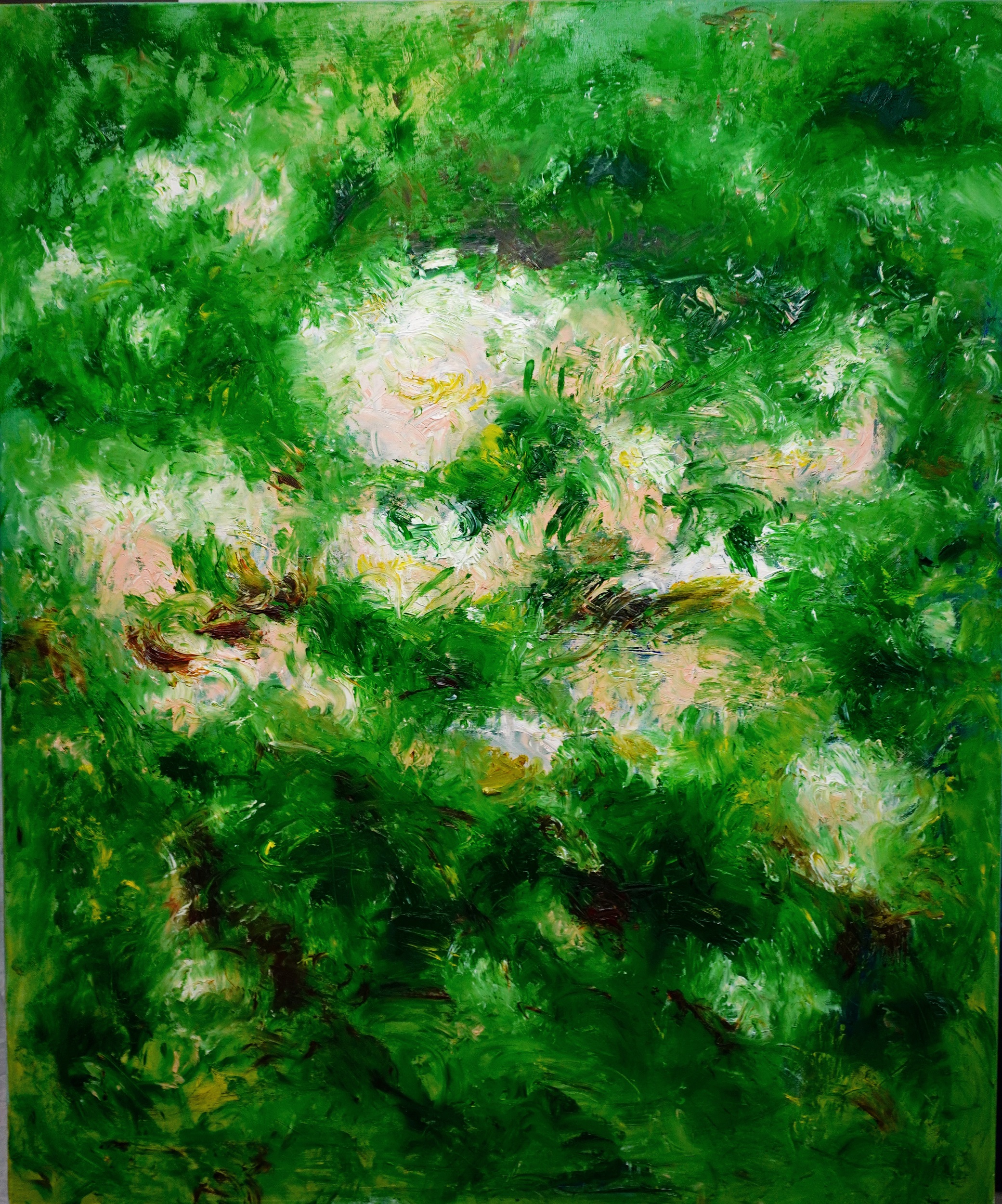

Evening (Blue Mist)
Ivan Alagakov, Pastel on paper, 17 x 23 cm, 2021
Moments that Move Us
Personal experiences that ripple into creative expression
Ebbs and Flows uses water as a metaphor for change and transformation. Can you describe a moment or experience that influenced your perspective on this theme and how it translates into your creative process?
Ola
An experience that strongly influenced my perspective on change and transformation is how the sea at Österlen can shift from a calm mirror to a storm in just a few minutes. In my creative process, I try to capture that very feeling. I work in layers – painting, washing out, building up again – much like how the sea shapes the coastline. It is not about recreating a specific landscape, but about translating an inner experience of movement and transformation.
Kang
In 2019, I witnessed heavy monsoon rains in Huangshan reshape the landscape in just a few hours, carving deep channels through solid rock. That moment revealed to me how water can be both a force of creation and destruction, and it has stayed with me ever since.
Storm
Ola W. Tappert, Mixed Media, 100 x 120 cm, 2024
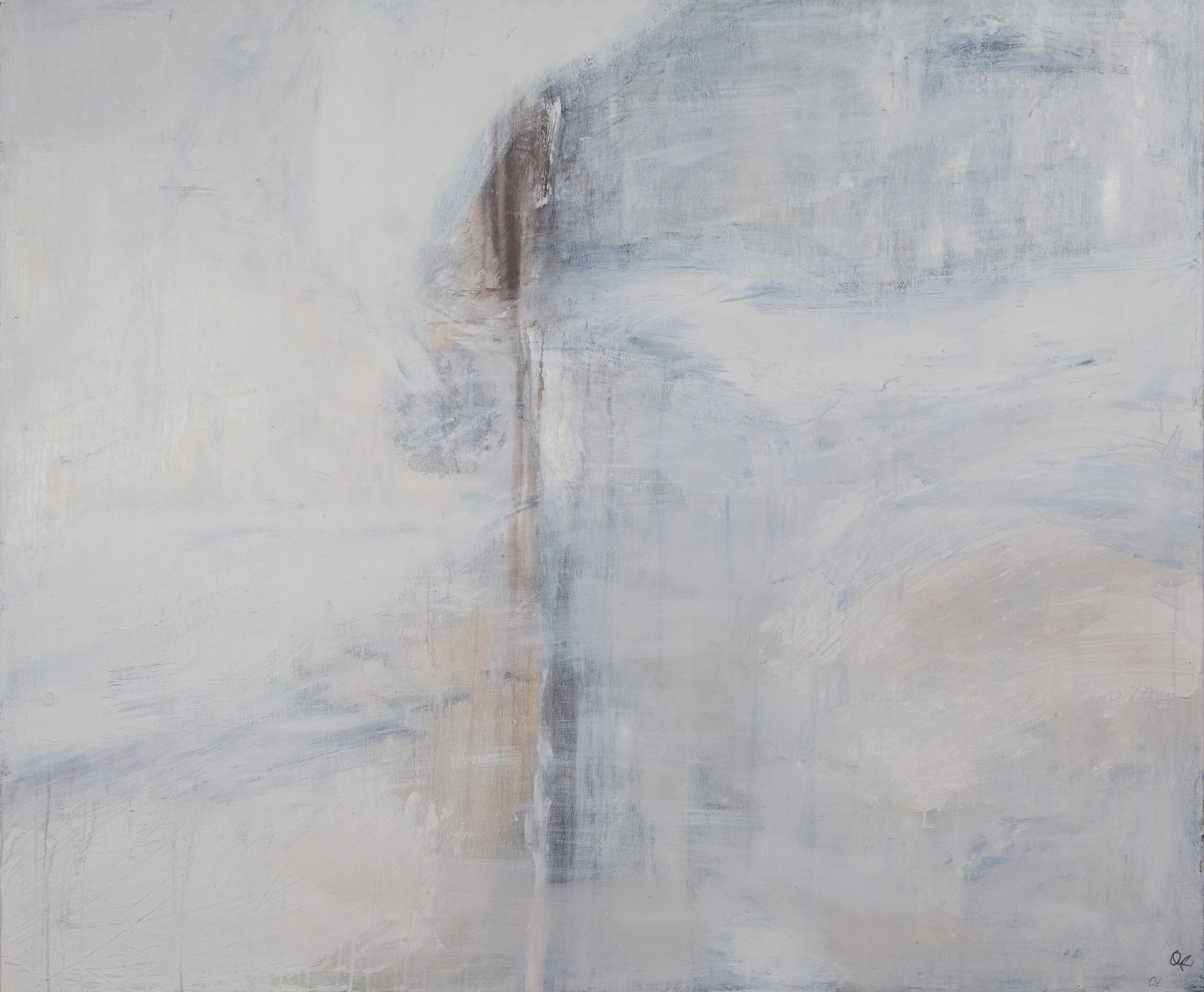
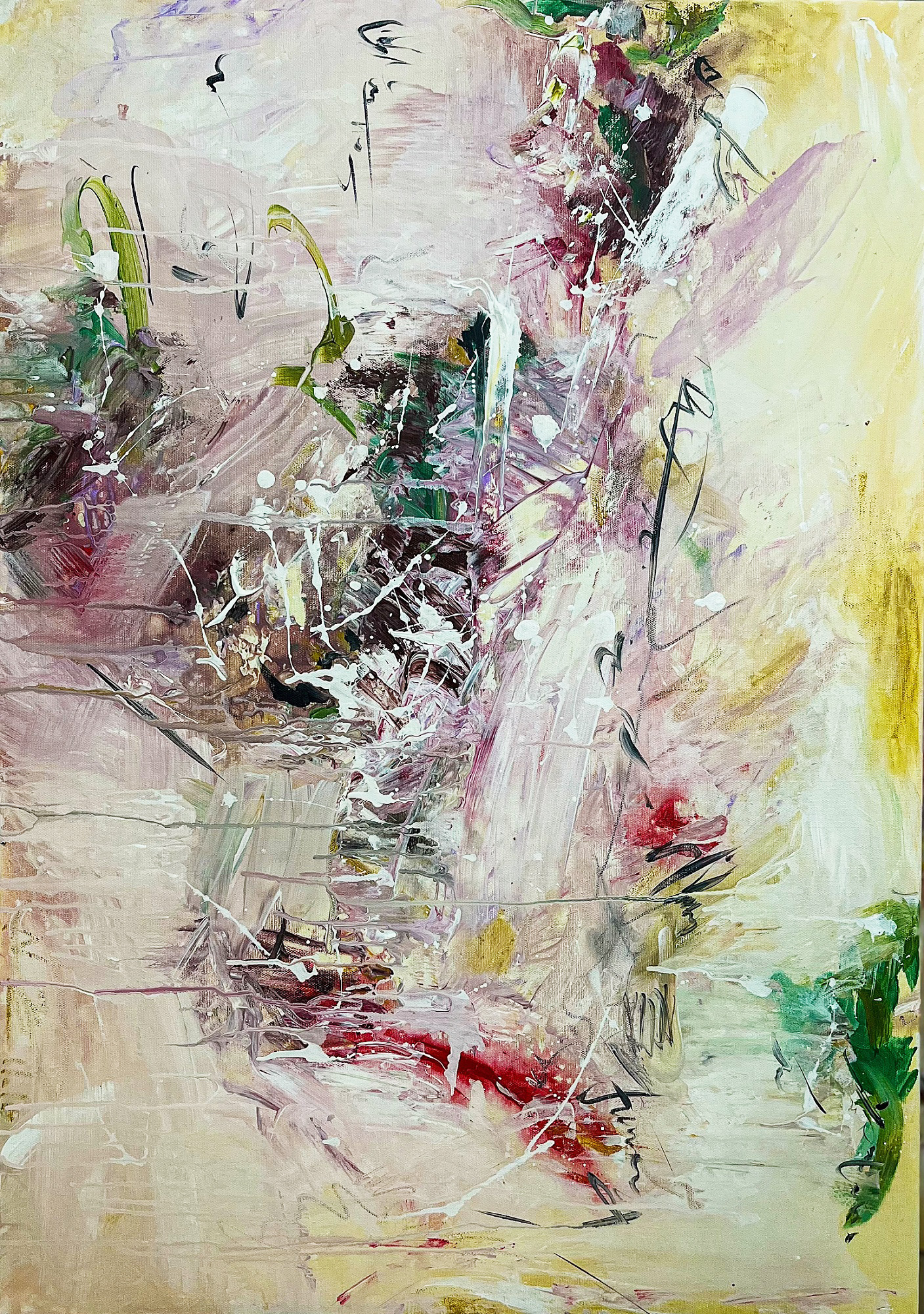
The Withering in the Ephemeral Dream of Life
Kang Ruan, Oil on canvas, 100 x 70 cm, 2023
Art as Anchor
Finding stability through creation in a world of uncertainty
How do you see art as a tool for navigating impermanence in a world of constant change? What role do you feel your art plays in helping viewers find stability and resilience?
Ivan
The very process of creating has become a part of my own adaptation to life. The world is moving extremely fast, and sometimes it's only through art that I can process events and my feelings and perceptions about them.
Art is both a medium and a channel of the artist's personal, maybe even intimate perspective - and feelings, emotions, moods... that are shared with those who observe it. In any case, whatever the topic is, I hope the audience will recognise the emotions imprinted into the art but also will see something completely new, which I'm even happier about. Although very private, this kind of channeling is not about self. It's simply a need while it's in me, like it happens with many artists afterall, but later it feels like I carry a responsibility of what I share with the world. Because as you know, art is an uniting experience - many can find themselves in one song or read same symbolism or personal message or recognise the same feeling in the same painting or sculpture... That's why after I first finish the artwork I run my own censorship - I ask myself: is this responsible to share with the world? What kind of impact can someone have from experiencing this same thing that I have experienced? It's more relevant when the topic is darker or more obscure but the thinking process is mostly alike nevertheless the topic when I am in that phase. Unsatisfactory answer to my own pondering sometimes inspires me to change some parts. So - even though rare, yes, change itself is actually a living element of creative process that can happen even from just contemplating the "final" look - in which I myself could first have thought there is no room for more of change.
Ola
In abstraction, there is a space where the viewer can rest, interpret, and perhaps find their own sense of stability.
For me, art is a way to pause amidst the movement. In a world where everything changes rapidly – both externally and internally – art can create a space for stillness and reflection. My paintings are inspired by the landscapes of Österlen, but not as they appear at a specific moment, rather as they are felt.
Kang
I hope viewers feel a quiet, physical connection to the passing of time, like stepping into a shifting tide.
In Red-Billed Blue Magpie, the glazed layers are meant to evoke a sense of motion, like catching the shimmer of a wing in flight or brushing against something fleeting yet vivid. With Spring, I want to create a moment of stillness, like the calm just before a storm. The raw textures and unfinished edges are meant to feel both delicate and alive, reminders that beauty can exist in moments of transition.
Ultimately, I hope people leave feeling subtly changed, as if the experience lingers, like salt on the skin after being in the sea.
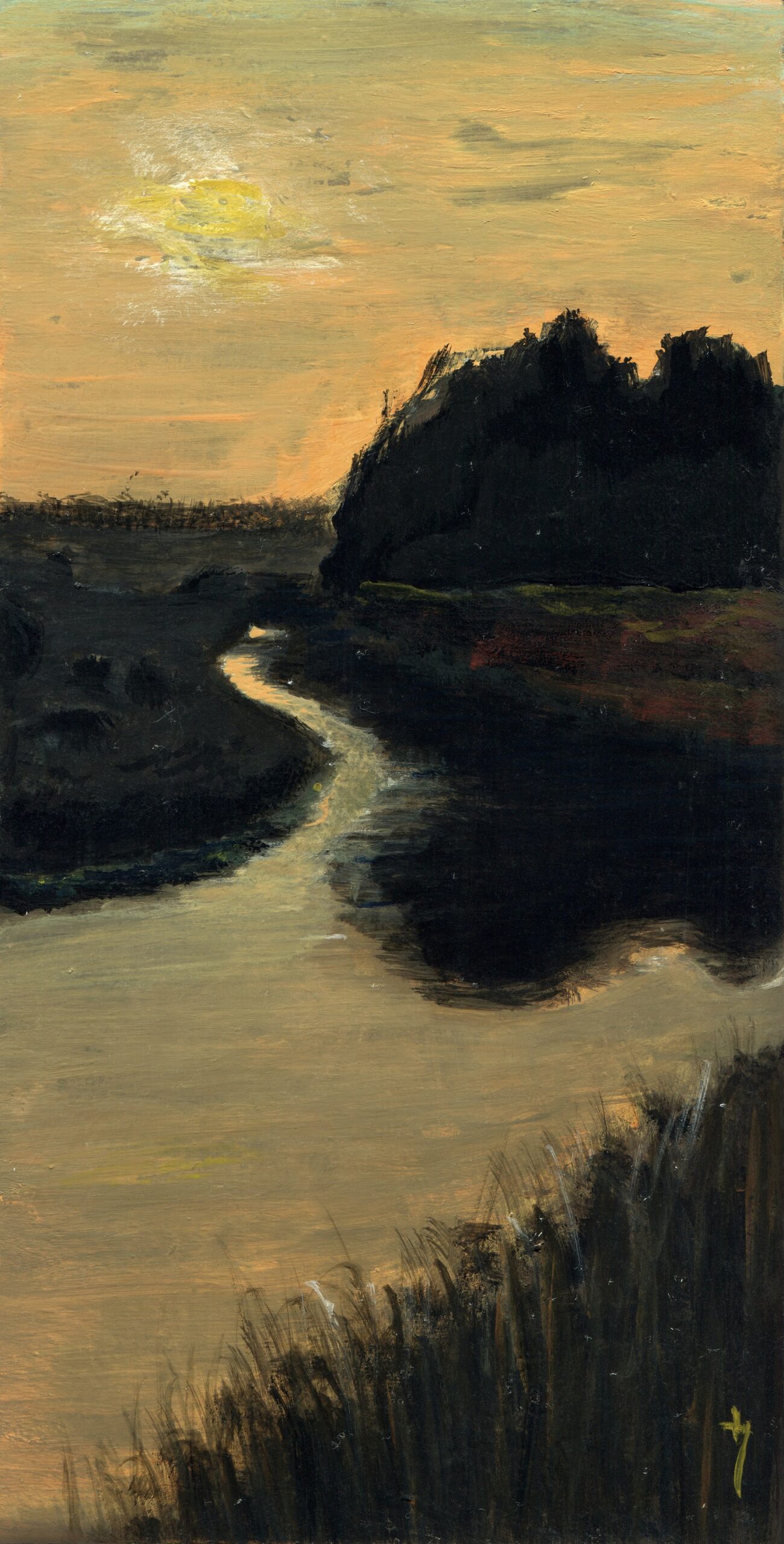
Evening by the Usozha River near the village of Zhideevka, Kursk region, after a day of archaeological excavations in July 2011
Ivan Alagakov, Tempera on hardboard, 20 x 10 cm, 2018
Orum
Ola W. Tappert, Mixed Media, 120 x 100 cm, 2025
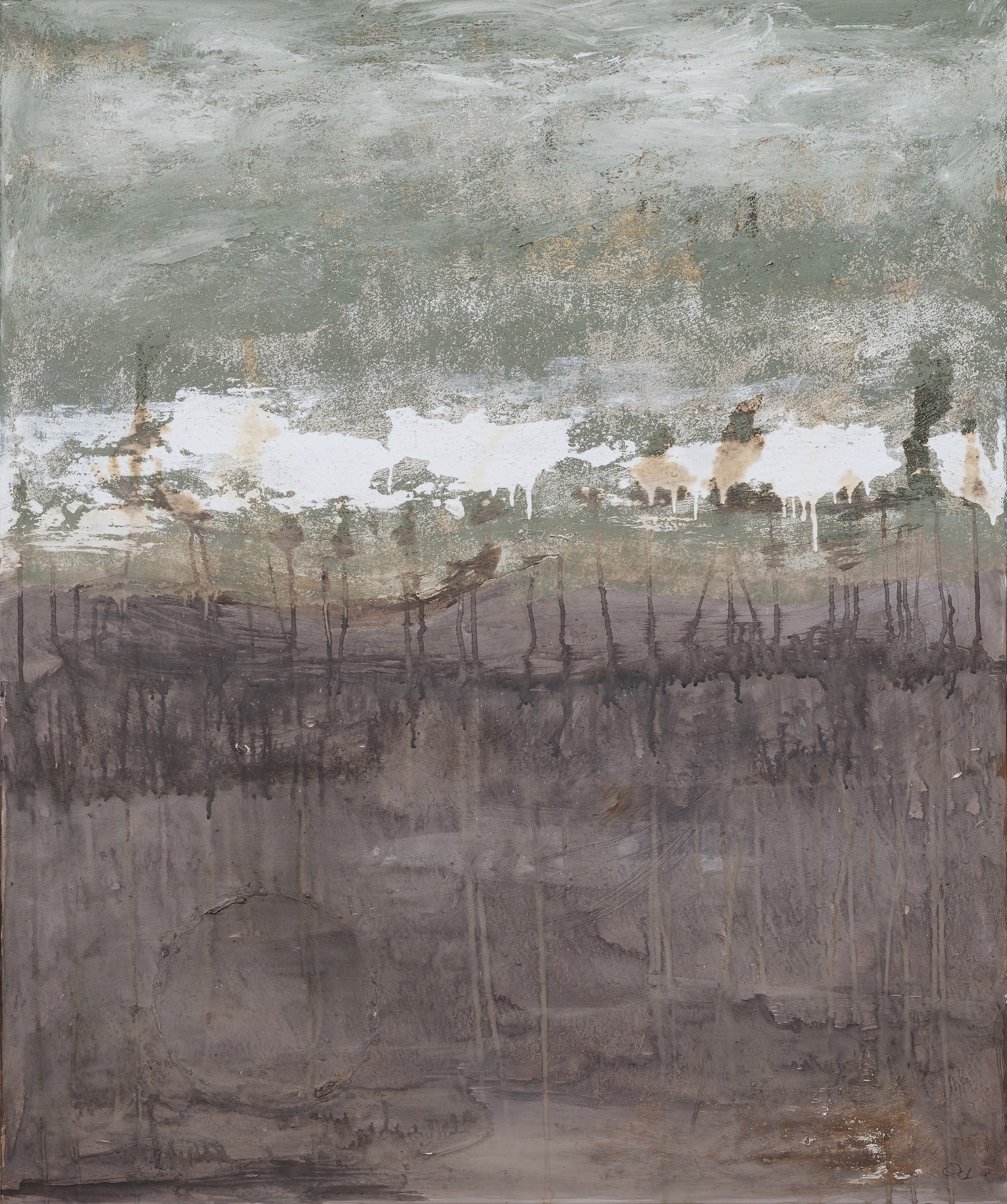
What the Heart Remembers
The sensations and emotions that ebb and flow through the work
What emotions or sensations do you hope viewers will experience when engaging with your work in the context of Ebbs and Flows?
Ivan
Above all, I hope viewers feel a sense of calm. The act of creating helps me stabilize chaotic emotions into balanced compositions, and I aim to share this tranquility. While each piece carries layered meanings, I want the serenity of quiet balance to resonate - like watching waves recede, knowing they will return, reshaped.
Ola
I hope the viewer experiences a sense of stillness, space, and perhaps a kind of inner movement – as if standing by the sea, letting thoughts drift with the waves.
Kang
I hope viewers experience a sensory journey when they engage with my works, a physical conversation about the nature of impermanence. As they leave, they carry a subtle sense of confusion, similar to how salt crystals cling to your skin after swimming in the ocean, with their minds still resonating with the ebb and flow of the tides.

Red-billed Blue Magpie
Kang Ruan, Oil on canvas, 180 x 100 cm, 2023
Night River
Ivan Alagakov, Pencil on paper, 12 x 18 cm, 2022

If the Work Could Speak
The unspoken messages embedded in color, texture, and form
If your artwork could "speak" to viewers, what message would it convey about adaptability and finding strength in the face of impermanence?
Ivan
Change is natural, since the world, the universe functions through seasons, polarities and coexistence of differences. The natural changes are not the ones that I fear - but the ones artificially done to nature, society and individuals by actual humans. Yet, in this insecure age of some scary possibilities and probabilities, where we anticipate or expect a change without even knowing sometimes what this change is going to bring - I believe we can still be inspired how nature does and deals with the changes. So my art could say: "don't stress yourself out, take it one thing at a time". The world is rushing us to do, see, process things very fast. But that is not a natural tempo. Whatever lasts long and whatever is natural, prepares long and then takes long time to fully take its place; completely settle in. If it could speak, my art with topic of change would also say: "it's okay to give yourself more time to process. Stay natural, stay humane - no need to rush to be more than a human. And no need to feel too weak to refuse to accept it either, that is not human spirit, as human spirit is stronger than that. It's just important to give yourself time for the process of acceptance. Strength lies not only in resistance, but also in yielding. Like water flows around dangerous rocks, so we can change our shape, but we must always strive to preserve our essence”.
Ola
If my work could speak, I think it would say: "It's okay to change. You don't have to hold on to be whole."
Just like the nature at Österlen, which always changes but never ceases to be itself, we too carry an inner core that can remain stable even in motion.
Kang
Red-Billed Blue Magpie would say:
"Look closely at my cracks, they aren’t signs of damage, but traces of storms survived. What seems broken is actually light finding new ways through."
Spring would add:
"My petals are left unfinished, reminding us that beauty doesn't last, but in stepping back, you’ll see how even what fades can come together with clarity."
Together, they suggest that change, loss, and imperfection aren’t things to fear, they’re the foundations of growth, insight, and strength.
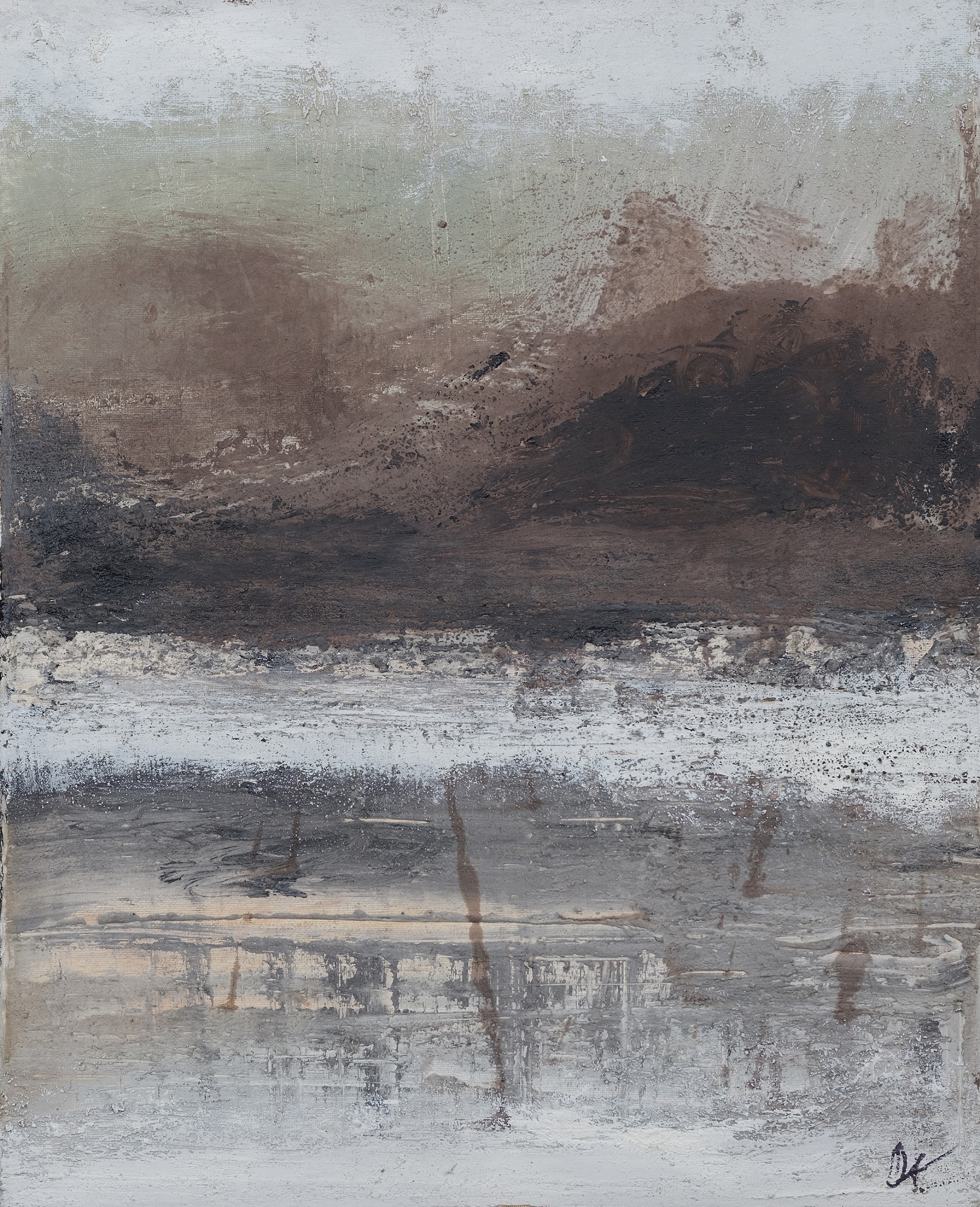
Hamnen
Ola W. Tappert, Mixed Media, 50 x 40 cm, 2024
The Love in the Ephemeral Dream of Life
Kang Ruan, Oil on canvas, 100 x 70 cm, 2023
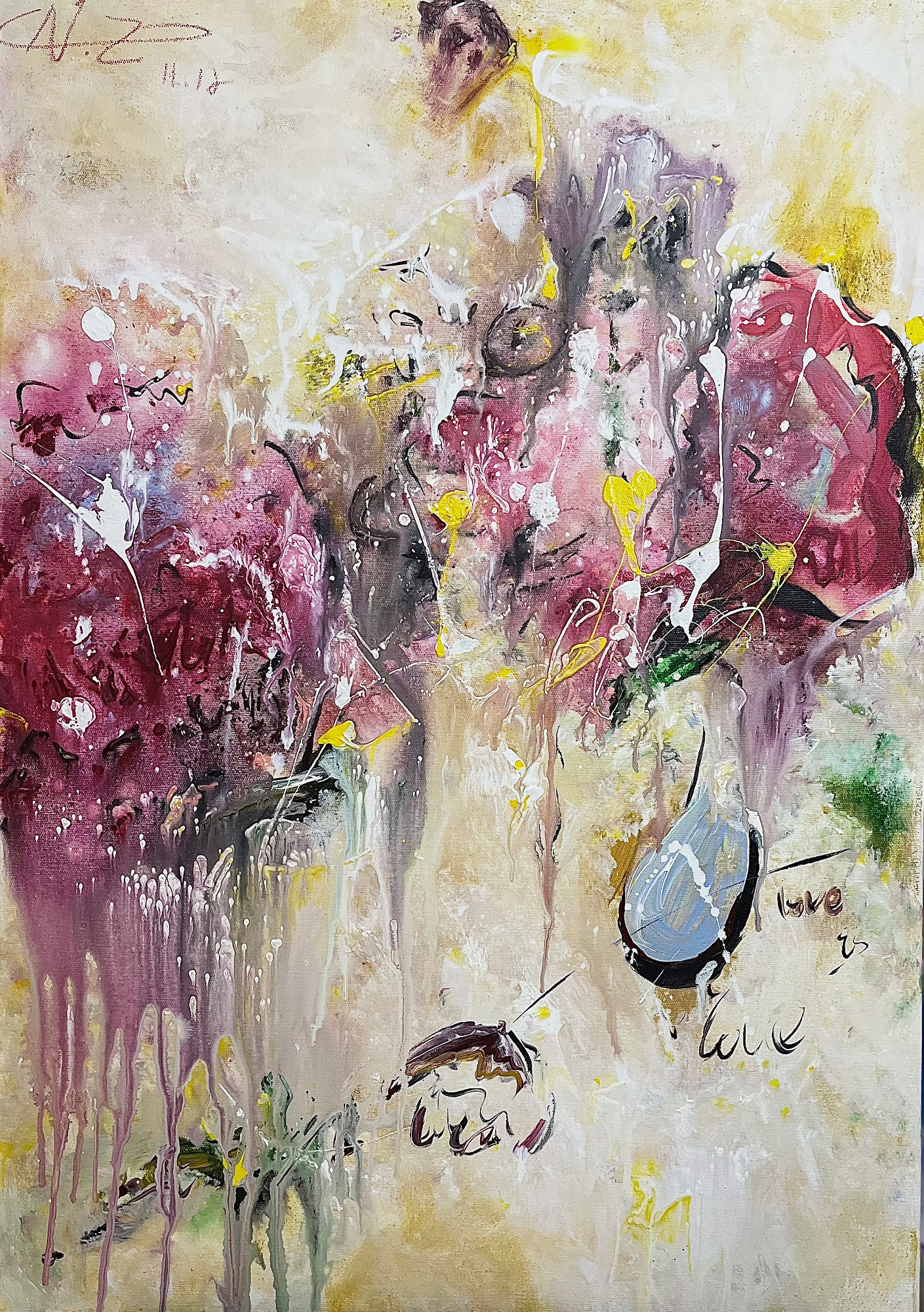
Where Art, Nature, and Humanity Intersect
A broader dialogue between ecology, expression, and existence
How does your work contribute to a broader conversation about the relationship between art, nature, and the human experience in a time of rapid change?
Ivan
My art often grapples with the tension between external or internal chaos and a yearning for silent peace. While I occasionally channel social themes or news into my work - filtering them through a surreal or symbolic lens - I return to nature as salvation. Painting landscapes allows me to dissolve not into the noise of human conflicts or introspective impressions, but into the quiet rhythm of water and mist, much like escaping urban clamor by stepping into a forest.
Ola
I hope my art can function as a bridge – between the external landscape and the internal. It can help us reconnect with something fundamental and human in a time when we easily lose our footing.
Kang
My paintings explore how nature, art, and our personal experiences are deeply connected, especially in this time of environmental crisis.
In works like Red-Billed Blue Magpie, I use patterns inspired by bird feathers and migration to reflect both nature’s resilience and human feelings of displacement. In Spring, I paint falling petals using natural growth patterns, inviting a deeper emotional connection to the cycles of life and decay.
I also use fragile, climate-sensitive materials, like pigments from unstable mineral zones or rainwater collected during storms, so that the work physically reflects the environmental shifts we’re living through.
Finally, I build my paintings slowly, layer by layer, encouraging viewers to slow down and really look. This kind of focused attention becomes an act of care, both for art and for the planet.
Through these choices, I hope the work becomes a bridge, helping us better see, feel, and respond to the world around us.
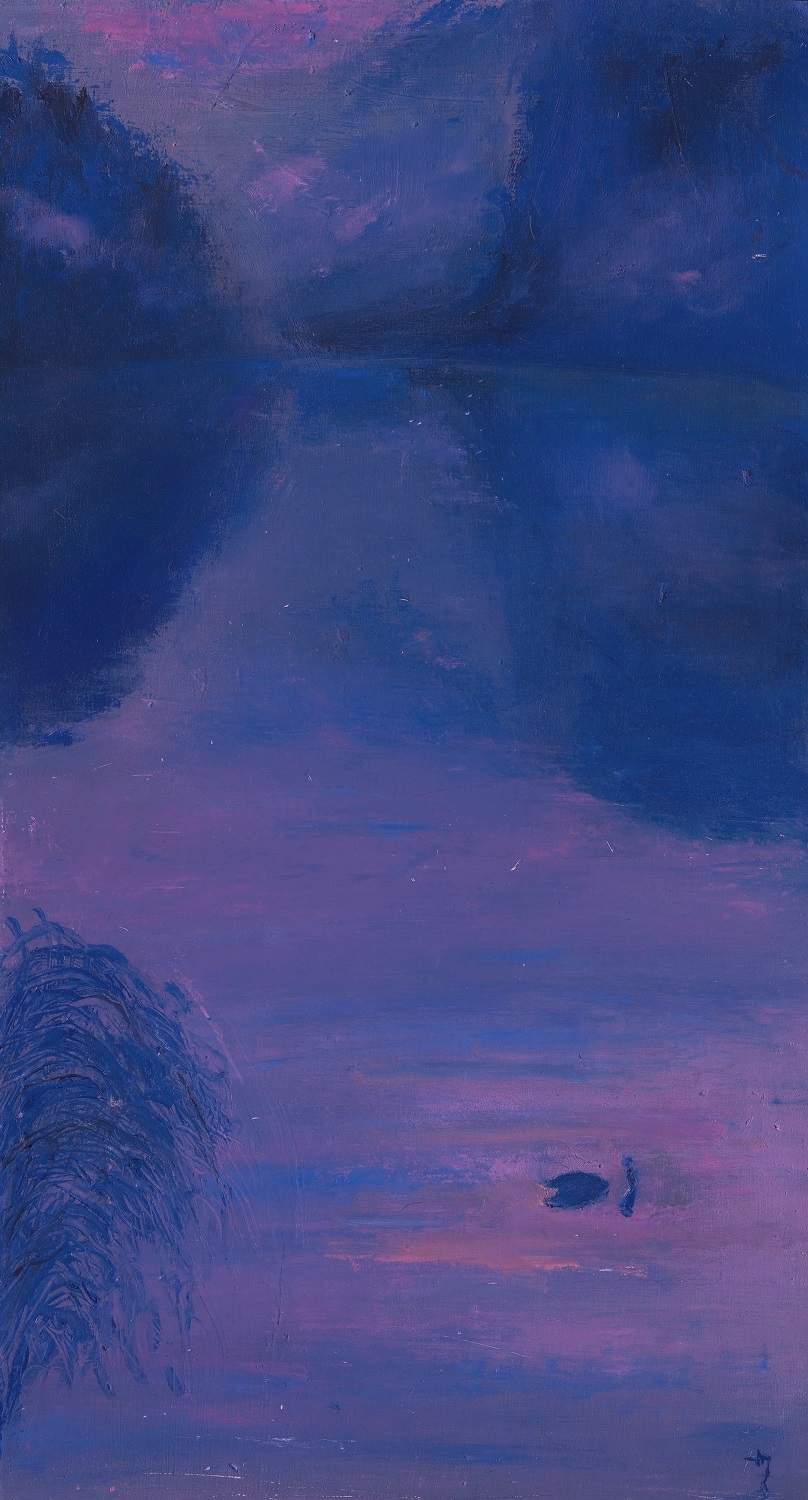
Evening (Blue Mist)
Ivan Alagakov, Oil on hardboard, 40 x 21 cm, 2022
A Story Within the Surface
Personal details that hold deeper meaning in the work
Is there a particular story or detail within your artwork that you find especially meaningful?
Ivan
In my surreal drawings, the compositions, like water, flow between fluidity and structure – solid forms dissolve into textures and many small details, and static lines hint at movement. Each of these details is as important to me as the overall image. It's like a puzzle where each piece has its own meaning.
The tempera painting of Usozha River in the exhibition holds a personal detail: it echoes memories of an archaeological expedition in Kursk oblast I participated in 2011 and of those beautiful warm evenings. That summer, I learned how layers of history quietly coexist in one place - just like the river, which has carried both ancient boats and modern reflections. I will forever wonder what did the Usozha river see throughout its existence. For me, it's another reminder of impermanence: how many different stories and emotions pass around the same place over time. But the quiet presence of eternity, in this case in the form of a river, has a calming effect on me. It's like a connection of times, like feeling part of something bigger.
Ola
I think about my work "Stenshuvud." In this piece, there is a detail that is particularly meaningful to me – the contrast between the heavy, brown mountains and the gray, rainy horizon. To me, the mountains symbolize something steady, almost ancient, while the horizon is more changeable and open – like a boundary where something can dissolve, or begin again. I let the rain-heavy colors remain fairly transparent in the horizon – almost as if the rain is blurring the landscape. It felt important not to "correct" it, but to let it be just as it is: a bit uncertain, a bit mysterious. Because often, it is in these moments that we feel the most.
Kang
Two years ago, I moved to the mountains outside Chengdu and began working closely with the natural world around me. My daily routine synced with mist, sunlight, and shifting seasons, and I started creating pigments from foraged materials, like dew from tea leaves or wild azaleas crushed into violet tones.
The paintings I made there became personal records of place and time. Summer storms shaped my textures; winter’s stillness led to minimal, mineral washes. Even the call of local birds influenced the rhythm of my brushwork.
Rather than simply depict nature, I aimed to merge with it, letting the landscape move through me and onto the canvas.
Stenshuvud
Ola W. Tappert, Mixed Media, 100 x 120 cm, 2024

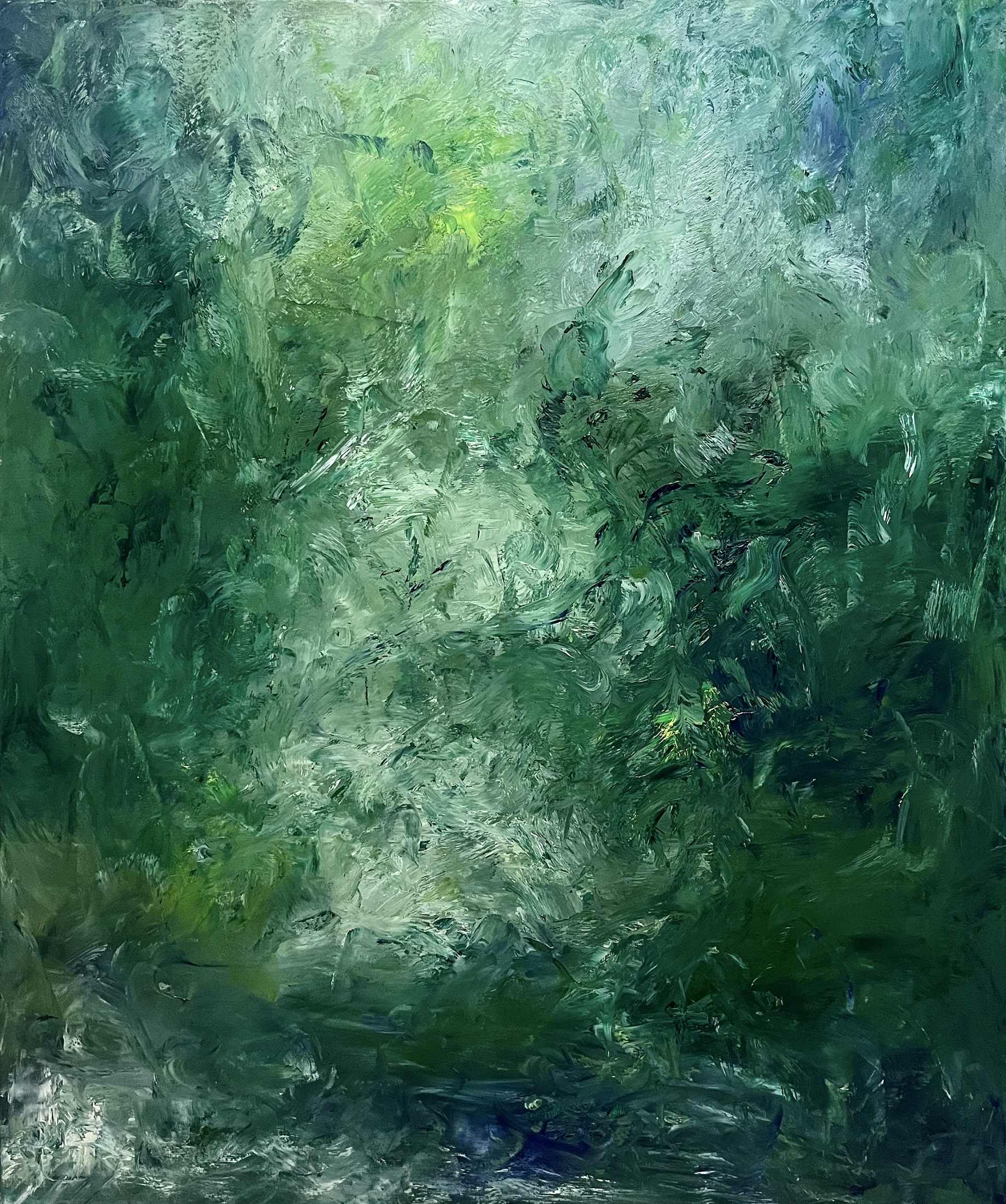
Dance of Spring
Kang Ruan, Oil on canvas, 120 x 100 cm, 2024
Thank you for joining us for Ebbs and Flows. This exhibition reflects Henki Art’s ongoing commitment to presenting meaningful, contemporary work that resonates with the present moment. If a particular piece has moved you, we invite you to explore further, whether through collecting, connecting with the artists, or simply carrying the experience forward. Art, like water, flows beyond its frame.
For pricing and availability, please contact us at info@henkiart.com
Produced by Henki Art | Ko Chen, Director
Become our VIP
Love this exhibition? Be the first to know about our next release.

